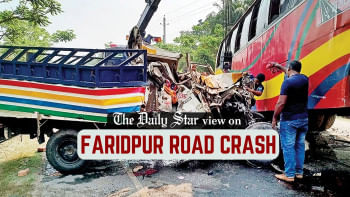Continued student deaths put the focus back on road safety

Six years after the nationwide road safety movement that was sparked by the deaths of two high schoolers, nothing seems to have changed in terms of the safety of commuters, including students. According to data released by the Road Safety Foundation (RSF), in the last five and a half years since 2019, some 34,478 people were killed in road crashes. Of them, 5,619 were students—making up 16.29 percent of all victims. While all such avoidable deaths are tragic, student fatalities are of particular concern considering their young age, their importance for the nation's future, and their starring role in the 2018 movement and subsequent acquiescence by the government. But as statistics show, they continue to be victimised as before.
Following the movement, we heard the authorities make numerous promises about improving road safety. Committees were formed, new laws and regulations were passed, and many crores of taka were spent in various projects. All of that evidently came to naught, with thousands perishing on roads every year. As per RSF data, 2,641 (47 percent) student victims were between the ages of 5-17, while 2,978 (53 percent) were between 18-25. Moreover, 1,534 (27.3 percent) of them were pedestrians. The fact that vehicle drivers were often reluctant to aid victims even after having hit them is another worrying sign.
The reasons RSF has identified as responsible for these incidents—including faulty roads and vehicles, lack of knowledge about safe road use, and reckless driving, including by student bikers—are well-known, which makes the glaring lack of results from government initiatives that much painful. According to a Prothom Alo report, over 600,000 vehicles are still operating without fitness certificates. One of the promises made after the 2018 movement was the removal of such vehicles from roads. How are so many of them still operating, then?
Clearly, the first thing we need at this stage is accountability for the failure of those behind such promises and initiatives. When a person dies in a road crash, it is not just the driver or vehicle owner who shares responsibility for it, but the system that protects or enables them is responsible, too. Over the years, we have seen how undue benefits and exemptions have been extended to transport associations. This needs to change. The authorities must go tough on those allowing unsafe vehicles and breaching other rules. They should also run awareness campaigns in educational institutions considering the vulnerability of students.


 For all latest news, follow The Daily Star's Google News channel.
For all latest news, follow The Daily Star's Google News channel. 









Comments